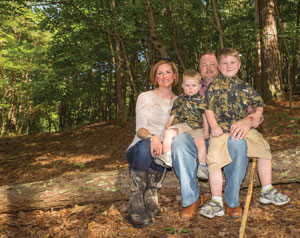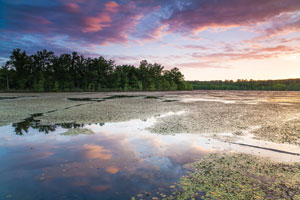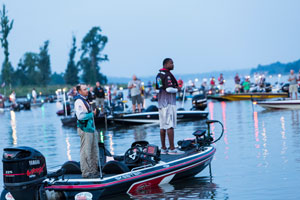
A place deep with memories
Story by Leigh Pritchett
Photography by Michael Callahan
Huckleberry Pond sits quietly between Sugar Farm Road and Riddle Road in Riverside.
Hardwoods and other trees knit a canopy as they stand in the shallow water near shore.
In the greater depths, tall and jagged trunks of dead trees jut toward the sky.
 The chirp of frogs breaks the silence and some unseen creature ripples the water.
The chirp of frogs breaks the silence and some unseen creature ripples the water.
The pond has been described as spooky, eerie, mysterious and, at the same time, beautiful.
It has different personalities, depending on time of day and season.
Daybreak is the favorite of Lance Bell, who owns 17 acres of the pond and 110 acres adjoining it. Wayne Spradley likes it best in early spring and late fall. Bobby Parker prefers winter.
One of its many moods is that “it looks like the Florida Everglades sometimes,” said Parker, who lives in Pell City.
“It’s a mystical-looking place with the dead trees,” added Greg Ensley of Pell City. “It’s a pretty place, a good place to go sit and watch animals.”
The stillness of the pond tends to shroud the fact that the place is actually teeming with memories.
 “In high school, we’d sneak over there and fish, (go) frog-gigging and kill a snake here and there,” said Bell, who grew up in Cook Springs and now lives in Riverside. “I think generations and generations before me did the same thing.”
“In high school, we’d sneak over there and fish, (go) frog-gigging and kill a snake here and there,” said Bell, who grew up in Cook Springs and now lives in Riverside. “I think generations and generations before me did the same thing.”
Frank Finch of Cropwell can attest to that. “We used to hang out over there when I was young.”
He and his cousins would ride a mule-drawn wagon to get there. That was in the early 1950s, when life was simpler.
“That was when kids knew how to use a weapon,” Finch said. “We killed things to eat; we’d fish on Huckleberry Pond. We knew how to take care of ourselves in the woods.”
The pond and the surrounding land just seemed to beckon those who wanted to explore, play, fish and hunt.
“It was a wild place. It was a place that was basically untouched,” Finch said. “It was a place to go back in time. We fought Indian battles. We fought World War II there, all the things that young boys do. Back then, it was a time of innocence. We didn’t have much. We enjoyed what we had.”
 The memories of Wes Guthrie of Pell City go back more than 40 years. As a young boy, he went to the pond with his grandparents, Hob and Iantha Guthrie (both deceased). They would fish or his grandmother would pick huckleberries and blackberries.
The memories of Wes Guthrie of Pell City go back more than 40 years. As a young boy, he went to the pond with his grandparents, Hob and Iantha Guthrie (both deceased). They would fish or his grandmother would pick huckleberries and blackberries.
“When we were young, we’d go there about once a month on a flat-bottom boat,” Guthrie said. “No trolling motor. Just a paddle and boat and your cane poles.”
Moss spanned much of the water’s surface, so it was necessary to put the fishing line down through a break in vegetation.
“It was good bream fishing and good bass fishing in the holes,” Guthrie said.
Huckleberry Pond held so much intrigue for Spradley when he was a boy that he would walk all the way from North Pell City to get to it.
“We went up there pretty often,” Spradley said. “We’d stay gone all day long.”
The fascination lasted right into adulthood, when Spradley – a renowned artist – chose Huckleberry Pond as the subject of his first wildlife print.
“(The pond) brought a lot of inspiration to me to do paintings,” Spradley said.
Through the years, Spradley has captured the pond, its mystery and its wildlife in several pieces of artwork.
Earlier this summer, he worked on several pencil sketches in preparation for his next Huckleberry Pond piece. Two sketches feature the pond’s familiar treescape. Another is of bluebirds flitting and diving.
The bluebird idea came to him from a fly-fishing experience about 15 years ago. Spradley saw bluebirds at the pond behaving in a manner he had not seen previously.
The birds would take flight, then dive down like kingfishers, Spradley said. “I didn’t have any idea bluebirds would do that. (They were) hitting the water, getting something to eat and carrying it back to the stump and eating it.”
For Dale Sullivan of Pell City, talking about Huckleberry Pond is somewhat of a sentimental journey.
“It’ll always hold a special place for me because I grew up there in its heyday. It was somewhere you wanted to go,” said Sullivan.
Many were the times he and his dad, Ernest Sullivan (now deceased) fished or hunted on pond property.
On occasions when the pond was frozen, Sullivan — as a youth — skated or rode bicycles on it.
One time while a teen, Sullivan borrowed his dad’s truck — without permission – to haul a boat to the pond. Once there, he decided to back the truck to the water’s edge to unload the boat.
By accident, he backed the truck into the pond. In the process of trying to get the truck out of the water, he nearly burned up the clutch.
Realizing he was in trouble, Sullivan begged a neighbor to use his tractor to free the truck.
The neighbor obliged and came with his tractor, which subsequently got stuck.
With the predicament now doubled in size, Sullivan called in the cavalry — which in this case was Riverside service station owner Frank Riddle.
Riddle brought his wrecker and extracted both the tractor and the pickup.
Then, Sullivan had to go home to tell his dad all that had transpired, as well as explain why the truck’s clutch would not function exactly right anymore.
“That’s one of my most vivid memories” about the pond, Sullivan said.
Just as the pond has been a natural source of human adventure, it has also been a haven that attracted animal life.
Those who frequented the pond through the years have seen quite an array of creatures, including chain pickerel, frogs, beavers, muskrats, deer, loggerhead and soft shell turtles, blue herons, snipes, whippoorwills, woodpeckers, numerous species of ducks and so very many other winged creations.
“You’ve never seen the like of birds there in all your life,” Ensley said.
In recent months, Bell has caught images on his game cameras of coyotes, bobcats and wild turkeys.
People also say the pond is fed by a spring and that the water is rather chilly in spots.
“It’s a unique place,” said Sullivan.
Protecting that uniqueness is one of the many reasons Bell purchased some pond property when it became available.
Bell said it is nice to own property that holds such a legacy of memories for so many people. He wants to preserve it and pass the legacy and the love of nature to his sons, Hudson and Holden.
The pond, which encompasses about 40 acres, is divided into three sections of ownership. Sonny and Jane Kilgroe of Pell City own another portion of the pond and bordering land. The third section belongs to Headwaters Investments Corp. of Atlanta, Ga.
Standing along the shore in an area not visible from Sugar Farm Road, Bell watched as his sons chatted and tossed sticks into the water.
“I enjoy watching them play out here,” Bell said.
Gazing out toward the middle of the pond, he said, “It’s beautiful, absolutely beautiful.”
His screensaver, he confessed, is an image of Huckleberry Pond.
Holly, his wife, said she wants to live on the expanse.
“I would like to build a house out here,” she said. “I like being out in nowhere, the slower pace.”
If it had been a snake …
Almost no tale of Huckleberry Pond, it seems, is complete without a snake story.
As a matter of fact, in enumerating some of the pond’s traits, Gordon Smith of Pell City listed snakes first.
“You would see them swim by,” Guthrie said.
Ensley said he has seen them, after dark, hanging from tree limbs close to the water, just waiting for a meal.
Sullivan has had several snakes in the boat with him, thanks to his dad. He said his dad would run the boat under a bush to make non-poisonous snakes fall into it, just to see the reaction of the occupants.
Spradley had the particular experience of falling out of a boat one time on Huckleberry Pond. “I don’t think I got wet getting back into the boat!”
Sometimes, Finch and his cousins camped overnight at the pond. But they were certain to sleep inside the wagon instead of on the ground to avoid any uninvited guests.
“There were some big snakes over there,” Finch said. “In the eyes of a child, every snake is pretty big.”
Then, there is the story of a teen-aged Dana Merrymon. He lived in the Center Star area at the time, and Sugar Farm Road was unpaved.
Merrymon and a buddy went fishing in a flat-bottom, aluminum boat. With them, they had a .410 shotgun, just in case of a serpent sighting.
The two guys had caught six or seven fish, which they put in the front of the boat. Merrymon sat in the middle of the boat, and his buddy was in the back.
It was growing dark as they rowed toward shore, but they stopped to fish one last time.
That is when Merrymon saw a head pop up out of the water. Then, the head and the rest of the body came right over into the boat to get the fish.
Merrymon yelled, “Snake!”
Almost instantaneously, he heard a deafening “boom” from behind him and realized that his buddy had shot at the snake.
The slithering visitor swam away unscathed.
But the boat was not so fortunate.
It started taking on water.
Although the water was only about thigh-deep where they were, neither fisherman wanted to be in it.
The two paddled with all their might to reach shore before the boat sank.
More than 40 years later, Merrymon, who lives in Pell City, tells that story with laughter and animation.
But at the time it happened, “it wasn’t funny,” Merrymon said. “I was scared to death!”
Additional assistance with this article provided by Realtors Bill Gossett and Carl Howard; Riverside Mayor Rusty Jessup; Porter Bailey; Julia Skelton; Vicki Merrymon; Jesse Hooks; David Murphy; Glenn Evans; John Pritchett; Jerry Smith; Bill Hereford; and April Bagwell of the county mapping department.
 Legend and tradition meet each year in Ashville when Lyman Lovejoy hosts the Lovejoy Slingshot Hunt in honor of his father, Sim Lovejoy. Breakfast and lunch, cooked over an open pit is always a treat, and the Lovejoys supply flips and ½ inch ball bearings for ammunition.
Legend and tradition meet each year in Ashville when Lyman Lovejoy hosts the Lovejoy Slingshot Hunt in honor of his father, Sim Lovejoy. Breakfast and lunch, cooked over an open pit is always a treat, and the Lovejoys supply flips and ½ inch ball bearings for ammunition. Most escape. It is not easy to hit a squirrel with a slingshot.
Most escape. It is not easy to hit a squirrel with a slingshot.




























































































































































































































































































































































































































































